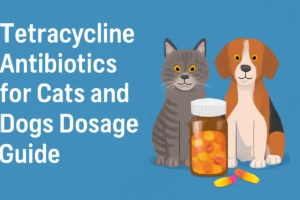Introduction
When using Tetracycline-type antibiotics for your pets, it’s crucial to administer the correct dosage to treat various bacterial infections effectively. These antibiotics can be a valuable tool in combating inflammatory skin conditions and even managing autoimmune diseases like lupus in dogs. However, it’s essential to remember that not all bacteria are susceptible to these drugs anymore. Over time, the rise of resistant bacteria has made it less common for Tetracycline-type antibiotics to be the first choice in treating some infections.
-
Correct Dosage: Essential to avoid complications from under or overdosing.
-
Bacterial Resistance: Resistant strains of bacteria may reduce effectiveness.
-
Veterinary Supervision: Ongoing evaluation and adjustment by a vet are needed.
Veterinarians often prescribe Tetracyn®, a well-known antibiotic, when they believe it’s the most effective option. Still, its effectiveness can be limited depending on the type of bacterial infection and the pet’s response. The resistant strains of bacteria mean that some pets may not respond as well as they once did to this treatment. This evolving challenge has made it necessary to reassess the role of Tetracycline-type antibiotics in modern veterinary care. For those pets who do respond positively, Tetracyn® can help manage inflammatory skin conditions and certain infections, but careful monitoring is required.

Ensuring the right dosage is a must, as too much or too little of this medication can lead to complications. If your pet suffers from chronic bacterial infections, working with a knowledgeable vet to find the right balance of Tetracycline-type antibiotics is essential. While Tetracyn® can still be beneficial, especially for dogs with lupus or similar conditions, its use requires ongoing evaluation to avoid overprescription and contribute to the ongoing fight against resistant bacteria.
Tetracycline Variants for Pets: Comparing Oxytetracycline, Doxycycline, and Minocycline
Tetracycline, often found under the brand name Panmycin®, is a commonly prescribed antibiotic for treating various infections in dogs and cats caused by susceptible bacteria. This class of medication also includes other variants like oxytetracycline, doxycycline, and minocycline, which are effective for similar bacterial infections.
- Tetracycline Variants: Includes oxytetracycline, doxycycline, and minocycline.
- Effective but Not First Choice: Growing bacterial resistance has made Tetracycline less of a first-line choice.
- Veterinary Guidance: Dosage should be based on the pet’s specific health needs.
Tetracycline Brand Names for Pets: Understanding Human vs Veterinary Formulations
When it comes to Tetracycline, whether you’re treating dogs or cats, there are several brand names to consider. For human formulations, you may come across Achromycin-V® (Lederle), Actisite® (Alza), and Topicycline® (Roberts), among others. These brands are often used for a variety of bacterial infections, though the dosage and application differ from what’s required for pets. For veterinary use, some of the more common small animal formulations include Panmycin® from Upjohn and Polyotic® by American Cyanamid. These are specifically designed for treating infections in cats and dogs.
- Human vs Veterinary Brands: Human formulations differ in dosage and application compared to pet-specific versions.
- Common Veterinary Brands: Panmycin® and Polyotic® are frequently used for small animals.
Common Uses of Tetracycline in Dogs and Cats: Treating Infections Effectively
Tetracycline is a powerful antibiotic frequently used for treating various bacterial infections in dogs and cats. It works effectively against bacteria that are susceptible to it.
- Effective for Bacterial Infections: Tetracycline is commonly used for skin infections, respiratory issues, and more.
- Correct Dosage: Ensuring proper dosage is crucial to avoid side effects.
- Alternative Options: If resistance occurs, your vet may recommend alternatives like doxycycline.
Tetracycline Dosage for Dogs and Cats: How Much Should You Administer?
- Dogs: 10 mg per pound (roughly 20 mg/kg) three times daily.
- Cats: 5 to 7 mg per pound (about 10 to 15 mg/kg) three times daily.
The condition your pet is being treated for plays a major role in determining how long the antibiotic needs to be given. It’s important to stay aware of your pet’s response to the medication. If their condition improves early in the treatment, don’t be tempted to stop the antibiotics prematurely. Always follow through with the prescription to avoid relapse and further complications like bacterial resistance.
Drug Interactions with Tetracycline: What to Avoid for Safe Treatment
When it comes to Tetracycline antibiotics for your pets, understanding potential drug interactions is essential to ensure safe and effective treatment. For example, Tetracycline should not be combined with bactericidal antibiotics such as aminoglycosides, penicillin, or cephalosporins. These combinations can reduce the overall effectiveness of both drugs.
- Avoid Combining with Certain Antibiotics: Aminoglycosides, penicillin, and cephalosporins can interfere with effectiveness.
- Timing with Antacids: Ensure proper timing between Tetracycline and antacids to prevent absorption issues.
- Monitor Other Medications: Always inform your vet about any other medications your pet is on.
Tetracycline Side Effects in Cats and Dogs: What You Need to Know
When administering Tetracycline antibiotics to your pets, especially cats and dogs, it’s essential to consider potential side effects that may arise. One of the most common problems associated with oral Tetracycline is its impact on the GI tract, leading to nausea, vomiting, diarrhea, and anorexia.
- Common Side Effects: Nausea, vomiting, diarrhea, and loss of appetite.
- Serious Effects: Photosensitivity, liver damage, and tooth discoloration.
- Pregnancy Risks: Avoid Tetracycline in pregnant or lactating animals due to risks to bone development.
Correct Dosage 10 mg per pound (dogs), 5-7 mg per pound (cats), three times daily Adjust based on pet’s condition Bacterial Resistance Tetracycline resistance is growing, reducing its effectiveness Consult vet for alternatives if resistance occurs Brand Names for Pets Panmycin®, Polyotic® Veterinary formulations are pet-specific Common Side Effects Nausea, vomiting, diarrhea, loss of appetite Contact vet if severe reactions occur Overdose Risks Vomiting, diarrhea, kidney damage (nephrotoxicity) Immediate vet consultation is crucial
Risks of Tetracycline Overdose in Pets: How to Prevent and Recognize Symptoms
When administering Tetracycline antibiotics for your cats and dogs, overdose is a serious concern. If your pet takes an acute oral overdose of Tetracycline, it may result in gastrointestinal disturbances, which include symptoms like vomiting, diarrhea, and general discomfort.
- Monitor for Overdose: Vomiting, diarrhea, and lethargy are common signs of overdose.
- Kidney Damage: Chronic overdose can lead to nephrotoxicity, affecting kidney function.
- Immediate Action: Contact your vet immediately if overdose is suspected.
Warning Signs of Tetracycline Overdose in Pets: When to Seek Emergency Help
If you suspect your pet has ingested too much Tetracycline, it’s crucial to be aware of the warning signs that could indicate an overdose.
- Early Symptoms: Vomiting, diarrhea, lethargy.
- Severe Symptoms: Abdominal pain, dehydration, seizures.
- Neurological Symptoms: Confusion, disorientation, or rapid breathing.
If you observe any of these symptoms, contact your veterinarian immediately.
Emergency Action: What to Do if Your Pet Overdoses on Tetracycline
In the event of a suspected overdose or adverse reaction to Tetracycline, it’s essential to take immediate action. Contact your veterinary office as soon as possible. It’s important to be prepared to provide essential information about the product, your pet’s weight, and any symptoms they are experiencing.

Safe Use of Tetracycline in Pets to Treat Bacterial Infections
Tetracycline antibiotics are effective tools for treating bacterial infections in pets, but their use requires careful attention. Proper dosage, timing, and ongoing monitoring are essential to ensure successful treatment. Always consult your veterinarian to ensure the correct treatment plan for your pet.


